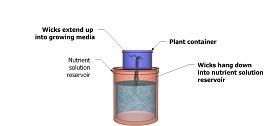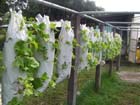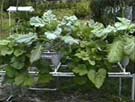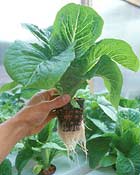Wick System
The wick system is the simplest of all six types of hydroponic systems. That's because traditionally it doesn't have any moving parts, thus it doesn't use any pumps or electricity.
 However some people still
like using an optional air pump in the reservoir. Because it doesn't
need electricity to work, it's also quite useful in places where
electricity cant be uses, or is unreliable.
However some people still
like using an optional air pump in the reservoir. Because it doesn't
need electricity to work, it's also quite useful in places where
electricity cant be uses, or is unreliable. The wick system is an easy type of system to build when first learning about hydroponics, and/or you just your want to get your feet wet first. This type of hydroponic system is also often used by teachers in classrooms as experiments for kids. Both to help explain how plants grow, as well as getting them interested in hydroponics.
What you need to build a wick system:
- A bucket or container for the plant.
- A bucket or container for the reservoir.
- A good wicking growing media like coco coir, Vermiculite, or perlite.
- Some strips of material like felt or good wicking rope.
 water to the plants through the
wick like a sponge. Typically good wick systems will have at least two
or more good size wicks to supply enough water (nutrient solution) to
the plant. The bucket/container with the plant in it basically sits
right above the container used for the reservoir. That way the water
doesn't need to travel up very far to get to the growing media with
plants.
water to the plants through the
wick like a sponge. Typically good wick systems will have at least two
or more good size wicks to supply enough water (nutrient solution) to
the plant. The bucket/container with the plant in it basically sits
right above the container used for the reservoir. That way the water
doesn't need to travel up very far to get to the growing media with
plants. Downside of wick systems
The biggest downside's to a hydroponic wick systems is that they don't really work well for larger plants that need to drink up more water. Their really more suited to grow smaller non-fruiting plants, like lettuce and herbs. While the wick does suck up (wick up) moisture to the plants roots, the larger the plant is, the more water it will need to drink up. If they are fruiting plants, they will need even more water to support the growth of all the water absorbing fruit as well.
Wick systems also have the disadvantage of being less efficient at delivering nutrients. Heavier feeding plants may need nutrients faster than the wicks can supply them to the roots. Lettuce and herbs are generally light feeders, while plants like tomato's, peppers and most fruiting plants are heavier feeders.
Another downside to wick systems is that plants don't absorb nutrients and water evenly, and the wick cant tell what nutrients the plant needs. The plants take the nutrients and water it needs, and leaves the rest of the nutrients in the growing medium. This can eventually cause a toxic buildup of mineral salts in the growing media. So flushing the excess nutrients from the root zone (growing media) with plain fresh water should be done regularly, like once a week or so.
Wicks
The wick itself is probably the most important part of the wick system, because without a good absorbent wick the plants would not get the moisture and nutrients it needs. You will likely need to do some testing of different materials to see what works best for you. When looking for a good wicking material, you'll want to use something that's absorbent, but is still resistant to rotting. Then washing the wick good first before you use it, can significantly improve the wicking ability of most materials.
Some common materials people have used for wick systems are things like, fibrous rope, propylene felt strips, tiki torch wicks, rayon rope or mop head strands, braided polyurethane yarn, wool felt, wool rope or strips, nylon rope, cotton rope, stripe of fabric from old clothing or blankets etc. etc.
Make sure to use enough wicks to support the plants water usage. That will depend greatly on how you build your wick system, type of plant your growing, and growing medium you use. You'll likely need at least 2-4 wicks unless it's a real small system. Also the shorter up the wick the water has to go from the reservoir to the growing media and roots, the more water it can transport to the growing media.
Once the nutrient solution makes it up the wick to the growing media, you want to use a very absorbent growing media to further wick up and hold moisture. Some of the most commonly used growing media's for wick systems are things like coco coir, Vermiculite or perlite. And in some cases, even water absorbing polymer crystals have been used too.
The Reservoir
The wick system reservoir can be large or small, you just don't want it to ever run dry. Also you want the water level to remain high enough so the water (nutrient solution) doesn't need to travel up very far to get to the growing media and root zone. You'll want to top off the reservoir with fresh nutrient solution as needed, as well as clean it out and change it completely once in a while too. Simply because algae and/or microorganisms can begin growing in the food rich water, especially if it's not light proof.
Because the wick sucks up water and nutrients evenly, and the plants don't use or absorb them evenly, a build up of excess nutrient salts can build up in the growing media over time. So you'll want to flush it with plain fresh water regularly as well. Probably something like about every couple weeks. That will reduce the likelihood of the nutrient salts building up and reaching toxic levels for the plants.
Optional air pump
Using an air pump and air stone to aerate the water in a wick system isn't necessary, however it can be beneficial. While the roots should be able to get oxygen from the small air pockets in the growing medium, they also absorb dissolved oxygen directly from the water itself as well. Along with helping to aerate the water, the moving, and rising bubbles keep the water circulating. Keeping the nutrient solution water moving around keeps the nutrients in it evenly mixed up all the time. If the water is still, the nutrients can settle toward the bottom over time. However if you are going to use an air pump anyway, you may want to just build a water culture system instead.




